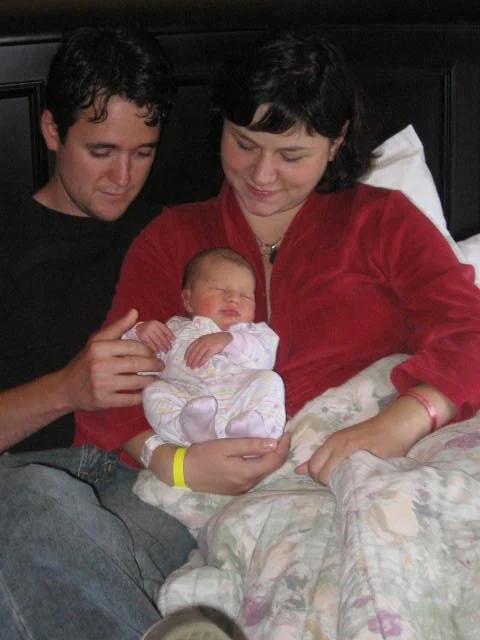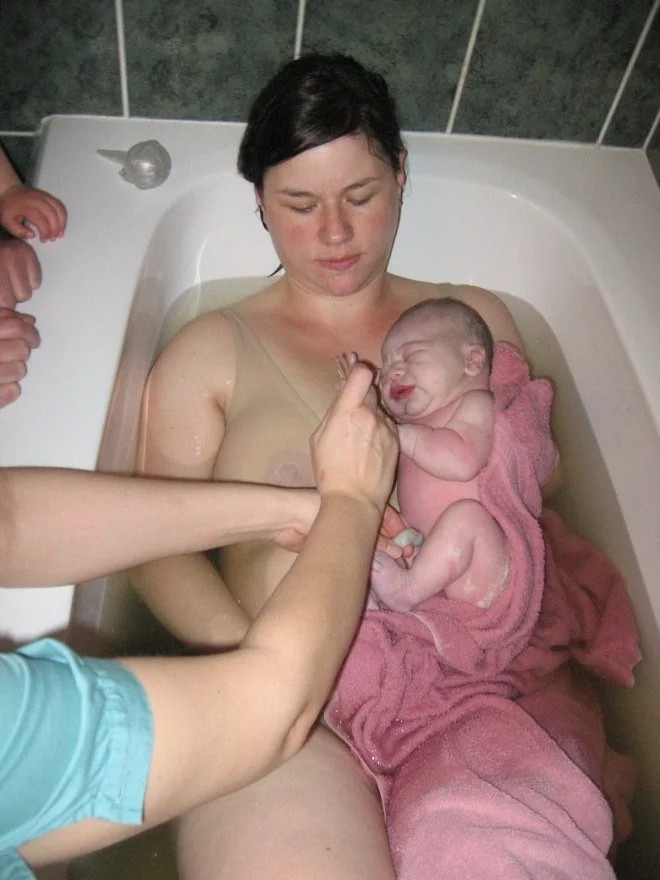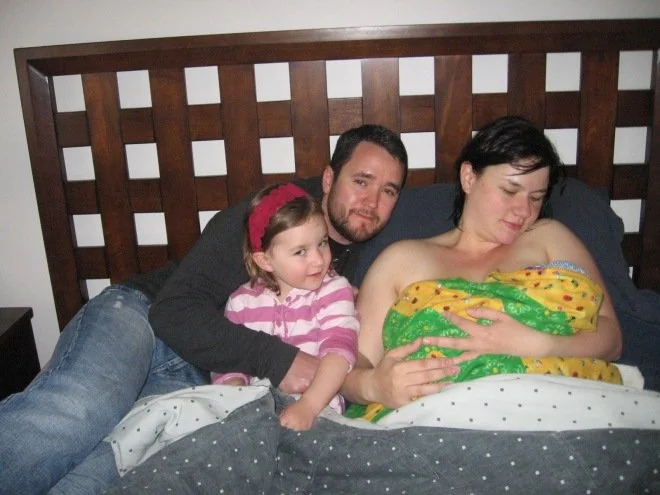I AM A BIRTH WARRIOR
By Leah Murphy
Previously published in Birth Issues Fall 2012
My first pregnancy in 2006 came to us quickly as we only tried for 2 months. I was thrilled just the same and finished my Registered Nursing degree, started my first nursing job, and wrote the RN exams, all while anticipating becoming a mother. It was challenging to divide my focus between two very important phases of my life, but also very exciting. I felt mentally and physically prepared and dreamed of a beautiful home birth, possibly in my bath, with my husband Lenny close by.
I found a midwife and spent many months preparing for and planning the birth I envisioned. Around midnight, August 1st my labour began as mild lower back pain. It was almost two hours later when my membranes ruptured (1) that I realized I was having contractions. I was so excited and I started to time my contractions, 8-10 minutes apart. It took all I had to wait until 3 a.m. to wake my husband and tell him that he wouldn’t be going to work that day.
Lenny got up and timed my contractions as we watched television. By 5 a.m. they were 5 minutes apart and painful. I decided to call our midwife. An hour later my midwife arrived and a couple hours after that, my girlfriend Melissa was there as well.
Sometime during the day my labour slowed down. I tried to eat and drink. I tried relaxing in the bath. Melissa massaged my back and feet. My labour and belly aches went on and on, but my cervix was not changing.
By 3 a.m. on August 3rd, I was frustrated, tired and worried that things were not progressing. My midwife and Melissa were encouraging and supportive while Lenny rested, and vice versa. I tried labouring in many positions, trying my best to help my baby to move down. Melissa and the midwife moved a towel across my belly during a few contractions while I was on all fours supported by the towel. This was very painful. I even walked up and down the stairs during contractions to try to rock my baby down.
By 8 a.m., I had been labouring for 30 hours. I was only 5 cm dilated (2) and feeling very discouraged. Perhaps my baby was presenting posterior, but it was never confirmed. I decided I needed help and we arranged to transfer to the hospital. I was aware the climate would change dramatically in hospital but I was determined to take things one step at a time by requesting the pitocin (3) drip to help dilate my cervix. My hope was that I hadn’t waited too long and still had the energy to birth my baby vaginally.
At the hospital, my midwives consulted with an obstetrician. The 10 a.m. assessment was worrisome. The staff did not like that I had been labouring so long with my bag of water broken (4) and the obstetrician said my cervix was swollen. His advice was to get an epidural (5,) pitocin drip (6), and that I would very likely need a caesarean section. I politely refused all treatment except the augmentation of my contractions with the drip. I wanted to birth as much on my own as I could. I wanted to feel the pain and joy of the birth of my baby.
The drip was started at 1 p.m., the contractions were extremely painful and I tried to stay in the shower to cope. My midwife, who stayed with us at the hospital, assured the nurse that my contractions were sufficient and discouraged increasing the rate of the drip.
Unfortunately, the fetal heart rate assessments were not done in the shower. Whenever it was time to check on the baby, a monitor was strapped to my belly and I had to lie down. Each assessment took 10 minutes and it was painful to lie on my back. With my midwife’s support, I tolerated the baby monitoring which felt like being strapped to the bed in torture. I started to feel like I was losing control and inhaled laughing gas (7) for the pain. This served as more of a distraction than pain relief. My soldiers were steadfast and standing by; Lenny, my midwife, and Melissa.
The drip made the contractions very difficult to bear—they were very strong and very frequent. By 4 p.m. I didn’t think I could handle any more pain and I asked for an epidural. At that time the anesthetist was not available, so I got into the shower and started feeling some pressure. The nurse asked me to return to the bed to assess my cervix, I was 9 cm dilated! I was elated, although in extreme pain, but so relieved that I was close to the end and my baby was coming. So we did not bother with the epidural and I gathered my strength and focus.
After 45 minutes of pushing, Ruby Melissa Murphy was born at 5:25 p.m., August 3rd 2006. I loved her instantly, my heart grew and I was hers the moment she looked into my eyes. I had endured and stayed strong. I was a birth warrior.
Two years later, we were ready to have another baby, and after 6 impatient months, I got pregnant. The pregnancy ended at 7 weeks, just before Christmas. I was devastated.
Six months later, in July 2009, I was pregnant again. Our family had just moved into our new home and Lenny joked that this baby wanted its own room! This pregnancy was a lot like my first with more heartburn, but this time, I had a 3 year old to keep up with. Most of the time I made a point to really enjoy being pregnant, as we were not planning to have another child.
Just like with Ruby, I looked forward to giving birth but hopefully this time it would be at home. I was also hoping for a shorter labour and boy did I get my wish! My Braxton Hicks8 contractions were stronger than in my previous pregnancy. As I approached my due date of April 11th, they were even waking me in the night.
The morning of April 8th, at about 7 a.m., I was not surprised to wake up in pain, except the pain was in my back as well as my belly. As I watched the clock I noted the pain was coming every 5 minutes, but it was very bearable. I wasn’t convinced it was labour until my girlfriend Tanya came by to check on me and I was unable to talk through the pain.
I took her advice and called my midwife at 10 a.m., having 2 contractions in our 3 minutes conversation. I also called Lenny at work at 11 a.m., and told him ‘not to rush’ home. I convinced Tanya that I could labour like this all day and that she should go to work and come over after to help with Ruby during the delivery.
Lenny came home at 11:30 a.m. My contractions where very painful;2 to 3 minutes apart. My cool-headed husband also thought this could go on all day. I was on all fours in the hallway, giving him orders in-between contractions; to get me water, the birth ball, to prepare the bed, and where the sheets were. He moved about calmly while tending to Ruby at the same time.
I soon realized I was feeling intense urgency as I started to get more vocal during contractions, yelling and moaning deeply. Lenny called the midwife at noon and then Tanya. My midwife arrived at 12:30 p.m. with her student and a great big smile. I remember her saying, “You are going to have your baby very soon!” It was like my mother and sister had arrived, two experts in the art of birth, instantly giving me comfort and support. They asked me where I wanted to deliver the baby and all I could do was point to the bathroom. I wanted to get into warm water so badly.
The midwife and her student fluttered about me preparing my tiny bathroom for delivery. The midwifery student, an experienced doula, gave me sacral pressure and I felt immense relief. My midwife coached me and assured me it was not too soon to get into the warm bath.
I was still thinking I had to keep up my stamina for a long journey. At about 1 p.m., I got up and got into my bath, my body was floating in relief in between contractions that were increasingly strong. My midwife wanted to see what progress I had made and checked my cervical dilation. I was assessed and my cervix was 4-5 cm dilated, 6 cm during a contraction.
I was in disbelief.I was so happy. I had made so much progress already. I was half way there! I remember saying that I could feel my cervix dilate and the student midwife said, “Good, then you know where to relax.”
I breathed deeply into the pain of the contractions, focusing on opening up. I actually felt my cervix open. Then the urge to push came over me like a tsunami9, I yelled and pushed out the bag of water still intact. There was a moment when the student called the midwife to the bathroom. They spoke a few words, then my midwife broke the meconium stained bag of water10. Luckily my baby wanted to come fast. I pushed 2 more times, letting out a primal scream that sent Ruby into daddy’s arms ; the head was out.
With the midwife’s encouragement, Lenny and Ruby came back into the bathroom to see the baby’s head which was out of my body but still underwater. I told Lenny where the camera was and to take a photo. One more push and my baby’s body was out. At 1:21 p.m. I reached down and picked up my beautiful baby boy from the water, Waylon Jeffrey Murphy. Ruby and Lenny came close to revel in the awe of the moment and see our new family member.
Then everybody took a breath. Tanya arrived and came into the bathroom in disbelief that I had already birthed the baby. Labour came hard and fast, and I endured. I was birth warrior.
Children are a gift no matter how they come to us. For me, becoming a mother is the most empowering and humbling experience. I believe giving birth to your child with awareness of choice, and conviction of intention is a gift to yourself and your baby. Being gratefully proud of how you handled your most challenging moments in birth, I believe, makes you a birth warrior. As proud as I am of my body birthing two babies, I am eternally grateful to those who supported, encouraged, and believed in me. It all started with a wish and my dreams came true. Thank you.
Leah Murphy traveled extensively and discovered she needed to be in a helping profession. Her career as a Registered Nurse started at the St. Albert hospital where she is a medical/surgical nurse. She always wanted to be a mother and loves providing a home filled with love, food, and play.
Editorial notes:
1. The membranes surrounding your baby in utero can rupture at any time after 37 weeks: 30% rupture before labour starts and 85% when a woman is pushing. Some caregivers like to know if your membranes break because there is a slight chance that the umbilical cord gets trapped while the water flows out, which could affect the proper oxygenation of your baby. These caregivers will want to listen to baby, check for fetal movement and the colour of the fluid. If your water is clear, or light yellow like pee, no concern. If it is brown or green and thick like pea soup, go immediately to the hospital. When the bag of water breaks, before the start of labour, contractions can take between 1 to 30 hours to start. Most caregivers will want you to go into labour within 24 hours. You may want to be careful about accepting vaginal exams as they push bacteria up the vaginal canal closer to baby, which heightens the risk of infection. Because of the cascading effects of arriving early at the hospital, which increase your chances for interventions, it is up to you to make an informed choice when your water breaks.
2. Dilation is when the cervix stretches and opens to allow for the baby to pass into the vaginal canal. It is measured in centimeters (0-10cm) with fingers by caregivers during a vaginal exam. Dilation is different for every woman, depending on how many babies she’s had, how low a baby is in her pelvis, how tired she is, how baby is positioned against her cervix, her state of mind, her sense of support, and of course, how relaxed she is. Textbook progression would be ½ cm an hour and at least some progress in 4 hours. However, some women progress faster and others slower. Dilation is only one of many ways to measure progress. Contraction pattern, mom’s behaviour, vaginal fluids, spotting, bag of water, vocalization, breathing, sensations of pain and the shape of the uterus are all indicators of progression.
3. It is the synthetic form of the naturally occurring hormone oxytocin. It can also be called syntocinon or pitocin. It is administered with an IV. It is used to contract smooth tissues in the body, which causes uterine contractions. It is given when a woman has an epidural, during an induction or an augment. There may be different reasons for it: perhaps your labour is long and you are tired, your contractions have slowed down, your contractions are far apart, your contractions are not long enough, we need to start labour, to rotate a baby in a more optimal position, or to prevent your labour to stop altogether.
4. When the bag of water is ruptured for a long time it is called “prolonged rupture of membranes.” Most caregivers will want you to give birth within 24 hours. Babies have a higher chance of being infected by bacteria because the bag of water that used to protect them is now open and any bacteria can travel into the water and to them. Infections can occur because of lack of personal cleanliness, if they are sick (e.g. they have a cold or the flu), they are exposed to bacteria in the environment (stores, schools, other children, sick people, hospitals, etc.), the presence of vaginal bacteria (STDs and Group B Strep), and vaginal exams (fingers will push bacteria up the vaginal canal closer to baby).
5. Epidural analgesia is an injection of a cocktail of drugs, including narcotics, into the epidural space of the spine. It blocks the highway of information to the brain, allowing a woman to not feel pain. Depending on the strength of the cocktail and her body’s reaction to it, she may feel nothing or will still feel a certain amount of pressure but without pain. It is used to help women cope with the pain of childbirth, allow a woman to relax (being high-strung would prevent her baby to descend into her pelvis), and have a vaginal birth rather than a cesarean section. An epidural has been associated with an increased risk of interventions—one intervention leading to another to compensate for the negative effects of the previous intervention.
6. When your caregiver wants your contractions to come more frequently and last longer, it is called ‘augment’ or ‘augmentation’. It involves a ‘drip’, which administers the synthetic form of oxytocin (either called pitocin, syntocinon, oxytocin) via an IV. Your caregiver may also suggest breaking your bag of water and accepting epidural analgesia. There are other less invasive methods to help increase your contraction pattern such as adopting gravity-friendly positions (walking, squatting, lunging, etc.), acupuncture, nipple stimulation, sensual massage, kissing, arnica, homeopathic remedies, verbena-castor-oil-cocktail, resting, and getting rid of everyone in the room. Sometimes privacy is all you needed.
7. Laughing gas, also called Nitrous Oxide, is an anesthetic drug, which is normally administered as a mixture with 50% gas and 50% oxygen in medical grade gas tanks, with the trade name Entonox or Nitronox. Inhalation is frequently used to relieve the sensation of pain associated with childbirth (it takes the edge of pain off), and has been shown to be a safe and effective aid for women wanting to give birth vaginally. It can make a woman feel temporarily dizzy, sleepy or nauseous. Stopping its use will allow a woman to quickly get back to normal.
8. Braxton Hicks contractions, also known as false labour or practice contractions, are sporadic uterine contractions that sometimes start around 6 weeks pregnancy. However, they are not usually felt until the last trimester of pregnancy. Not all expectant mothers feel these contractions. They are thought to be an aid to the body in its preparation for birth as they will help stretch and dilate the cervix before going into labour.
9. Once a woman’s cervix is fully dilated, she will have an overwhelming natural urge to push. It is called “the fetal ejection reflex”. A woman instinctively knows how to push so refrain from telling her what to do.
10. Caregivers will monitor a baby closely if they notice any staining of the amniotic fluid. The main reason being that the presence of meconium could indicate that the fetus is being compromised and needs to be born and be attended to. Also, caregivers may want to prevent infections of the lungs and decide to aspirate any meconium that may have been breathed in when baby took his or her first breath. Caregivers may also want to make sure baby is breathing without effort.



